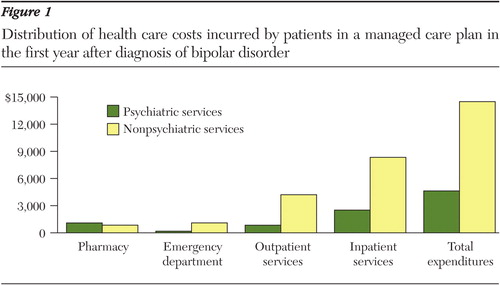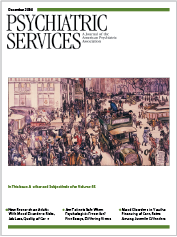Datapoints: Costs Associated With the Treatment of Patients With Bipolar Disorder in a Managed Care Organization
The estimated lifetime prevalence of bipolar disorder in the United States is currently 1 to 1.5 percent (1). Economic studies have shown that the treatment of bipolar disorder is associated with substantial costs to patients, their families, and society as a whole (2). Estimates from economic models have put the costs of bipolar disorder between $24 billion and $45 billion each year (3).
Our study examined the direct health care expenditures incurred by patients in a managed care plan in the first year after diagnosis of bipolar disorder from the payer's perspective. This study used a retrospective analysis of pharmacy and medical claims from a large network-model managed care organization that represents 2.7 million members in the United States.
Adult patients were identified who had at least one medical claim with a primary diagnosis of bipolar disorder (ICD-9-CM codes 296.40 to 296.99) between July 1, 2000, and June 30, 2001. The date of the first diagnosis in this period served as the index date. Patients were excluded from the analysis if they had been given a diagnosis of bipolar disorder in the year before the index date or if they were not continuously enrolled in the health plan in the year before and the year after the index date.
A total of 4,397 patients met the study criteria. The mean±SD age of the identified patients was 53.1±16.9 years, and 66.1 percent were female.
Figure 1 shows that total health care costs for identified patients in the first year after diagnosis were $19,116 per patient, compared with the total health care costs of $4,348 that the average member in the health plan incurred. Inpatient costs accounted for the largest proportion of incurred costs (56.7 percent), followed by charges for outpatient physician visits (26.4 percent).
In the first year after the initial diagnosis of bipolar disorder, the patients in our study incurred nearly $85 million in annual health care costs. Of this, only 25 percent was related to mental health services. The fact that patients with bipolar disorder incurred more than four times the health care charges of the average member in the health plan speaks to the need for innovative and creative programs to manage this population.
Acknowledgment
This research was supported in part by Bristol-Myers Squibb.
Dr. Knoth is a senior research scientist in the pharmacoeconomics and health outcomes research group at Prescription Solutions, 3515 Harbor Boulevard, Costa Mesa, California 92626 (e-mail, [email protected]). Dr. Chen is a senior research associate with Cerner Health Insights in Beverly Hills, California. Dr. Tafesse is the associate director of global epidemiology and outcomes research at Bristol-Myers Squibb in Wallingford, Connecticut. Harold Alan Pincus, M.D., and Terri L. Tanielian, M.A., are editors of this column.

Figure 1. Distribution of health care costs incurred by patients in a managed care plan in the first year after diagnosis of bipolar disorder
1. Kessler RC, McGonagle KA, Zhao S, et al: Lifetime and 12-month prevalence of DSM-III-R psychiatric disorders in the United States: results from the National Co-Morbidity Survey. Archives of General Psychiatry 51:8–19, 1994Crossref, Medline, Google Scholar
2. Stimmel GL: The economic burden of bipolar disorder. Psychiatric Services 55:117–118, 2004Link, Google Scholar
3. Begley CE, Annegers JF, Swann AC, et al: The lifetime cost of bipolar disorder in the US: an estimate for new cases in 1998. Pharmacoeconomics 19:483–495, 2001Crossref, Medline, Google Scholar



